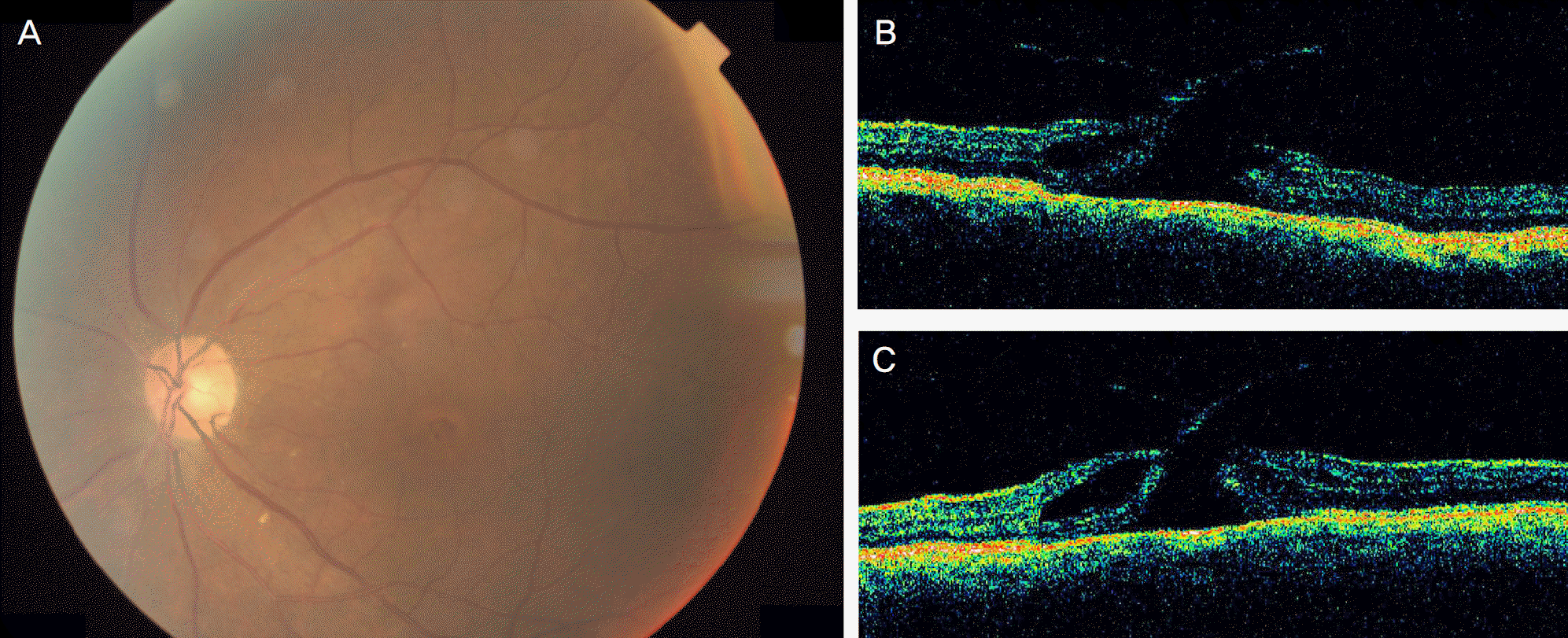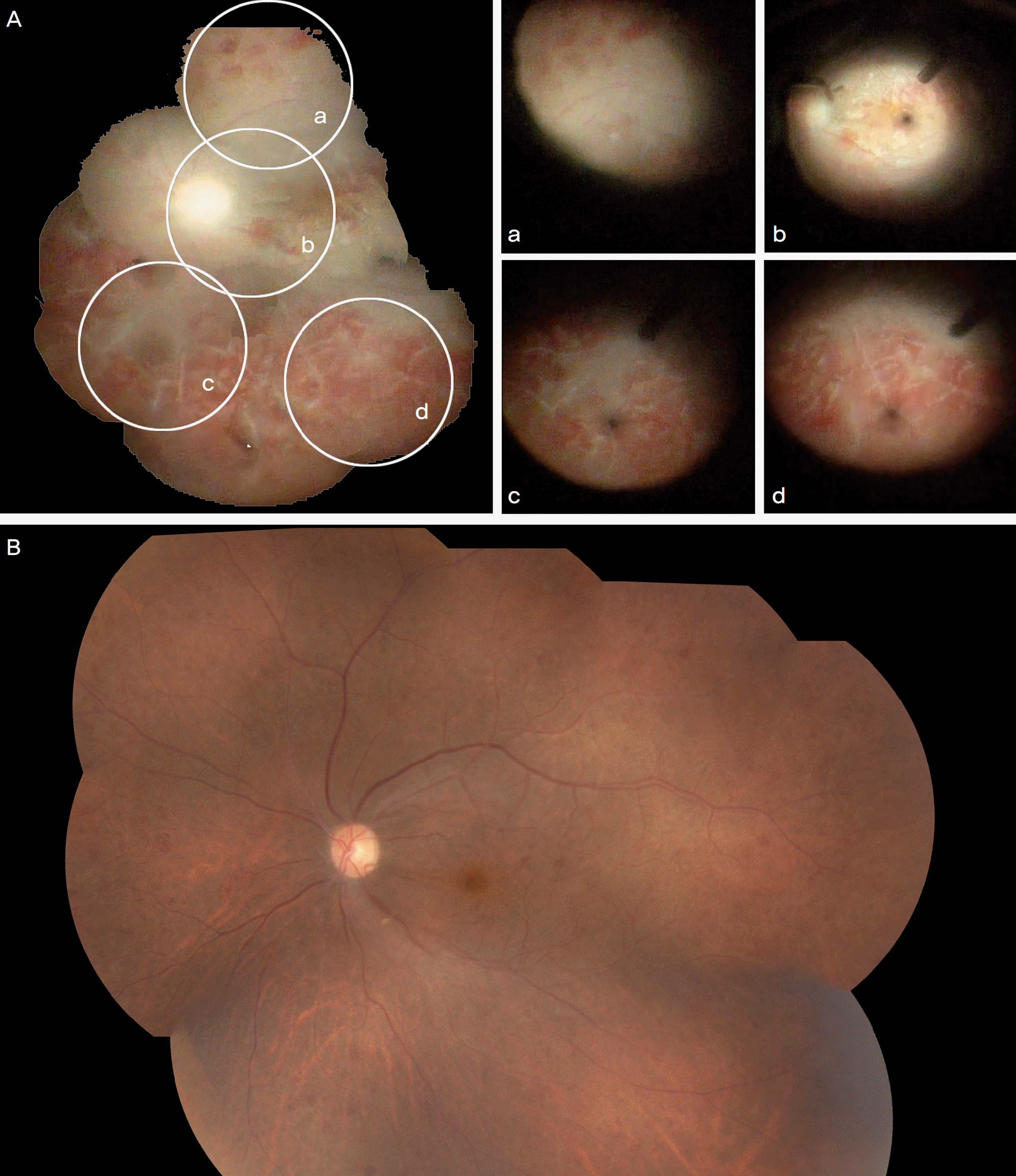Abstract
Purpose
To report a case of acute endophthalmitis associated with 23-gauge transconjunctival sutureless vitrectomy and gas tamponade for macular hole surgery.
Case summary
A 66-year-old female patient who presented with a macular hole in the left eye was treated with 23-gauge transconjunctival sutureless vitrectomy. On postoperative day 2, the patient developed acute endophthalmitis and was treated with gas-fluid exchange, lensectomy and intravitreal antibiotic injection. Staphylococcus epidermidis was detected in the vitreous fluid of the operated eye. Intraoperative fundus findings showed severe retinal hemorrhage, vascular occlusion and fibrous membranes due to inflammatory response. After treatment, the patient’s fundus findings markedly improved and the inflammatory response was controlled.
References
1. Misra A, Ho-Yen G, Burton RL. 23-gauge sutureless vitrectomy and 20-gauge vitrectomy: a case series comparison. Eye. 2009; 23:1187–91.

2. Warrier SK, Jain R, Gilhotra JS, Newland HS. Sutureless vitrectomy. Indian J Ophthalmol. 2008; 56:453–8.

3. Sprirn MJ. Comparision of 25, 23 and 20-gauge vitrectomy. Curr Opin Ophthalmol. 2009; 20:195–9.
4. Gupta OP, Ho AC, Kaiser PK, et al. Short-term outcomes of 23-gauge pars plana vitrectomy. Am J Ophthalmol. 2008; 146:193–7.

5. Kunimoto DY, Kaiser RS; Wills Eye Retina Service. Incidence of endophthalmitis after 20- and 25-gauge vitrectomy. Ophthalmology. 2007; 114:2133–7.
6. Scott IU, Flynn HW Jr, Dev S, et al. Endophthalmitis after 25-gauge and 20-gauge pars plana vitrectomy: incidence and outcomes. Retina. 2008; 28:138–42.
7. Shimada H, Nakashizuka H, Hattori T, et al. Incidence of endophthalmitis after 20- and 25-gauge vitrectomy causes and prevention. Ophthalmology. 2008; 115:2215–20.
8. Parolini B, Romanelli F, Prigione G, Pertile G. Incidence of endophthalmitis in a large series of 23-gauge and 20-gauge transconjunctival pars plana vitrectomy. Graefes Arch Clin Exp Ophthalmol. 2009; 247:895–8.

9. Hu AY, Bourges JL, Shah SP, et al. Endophthalmitis after pars plana vitrectomy a 20- and 25-gauge comparison. Ophthalmology. 2009; 116:1360–5.
10. Lee JW, Kim DJ, Shin JP, Kim SY. A Case of endophthalmitis after 25-gauge transconjunctival sutureless vitrectomy. J Korean Ophthalmol Soc. 2007; 48:172–8.
11. Park KS, Park YG, Min WK, Ahn BH. Microbiological diagnosis and visual outcome of infectious endophthalmitis. J Korean Ophthalmol Soc. 1994; 35:1715–22.
12. Cohen SM, Flynn HW Jr, Murray TG, Smiddy WE. Endophthalmitis after pars plana vitrectomy. The Postvitrectomy Endophthalmitis Study Group. Ophthalmology. 1995; 102:705–12.
Figure 1.
Fundus photograph (A) and horizontal (B) and vertical (C) opitical coherence tomography (OCT) images reveal a stage 2 macular hole before surgery.

Figure 2.
Intraoperative fundus findings show severe retinal hemorrhage, vascular occlusion and fibrous membrane due to inflammatory response (A, a-d) (A: digitally reconstructed image from the video recording of the operation, a-d: captured image from the video recording, each character indicates the location of the image from the reconstructed image). After treatment, fundus findings markedly improved and nearly normalized (B).





 PDF
PDF ePub
ePub Citation
Citation Print
Print


 XML Download
XML Download